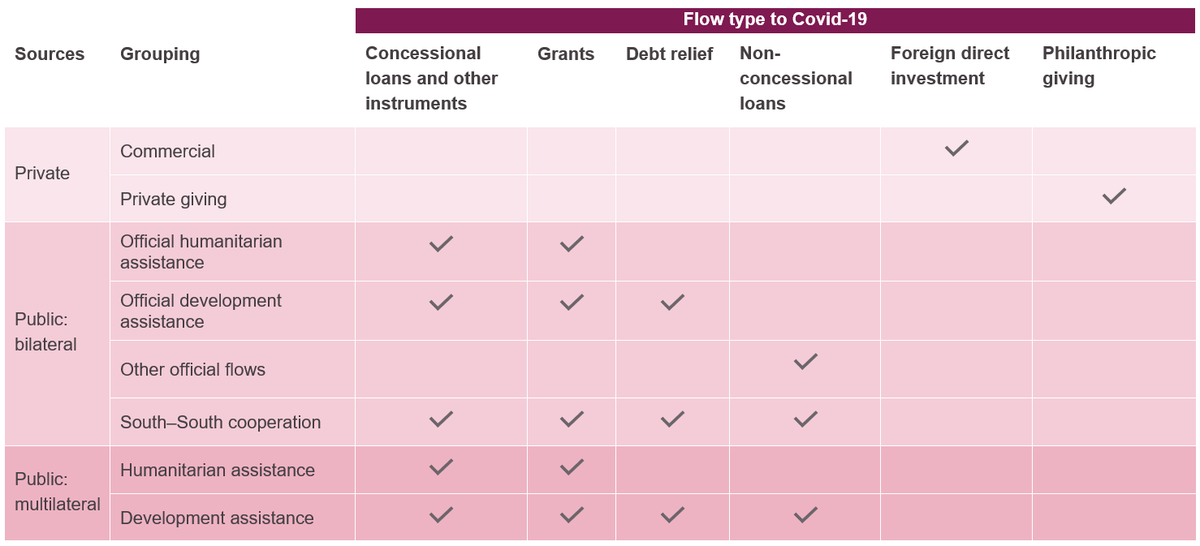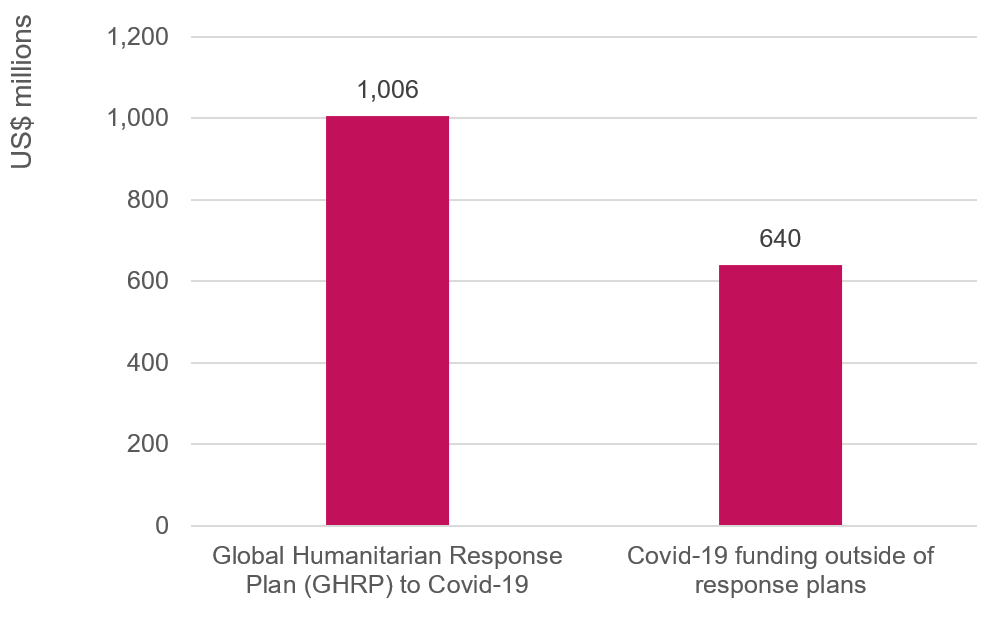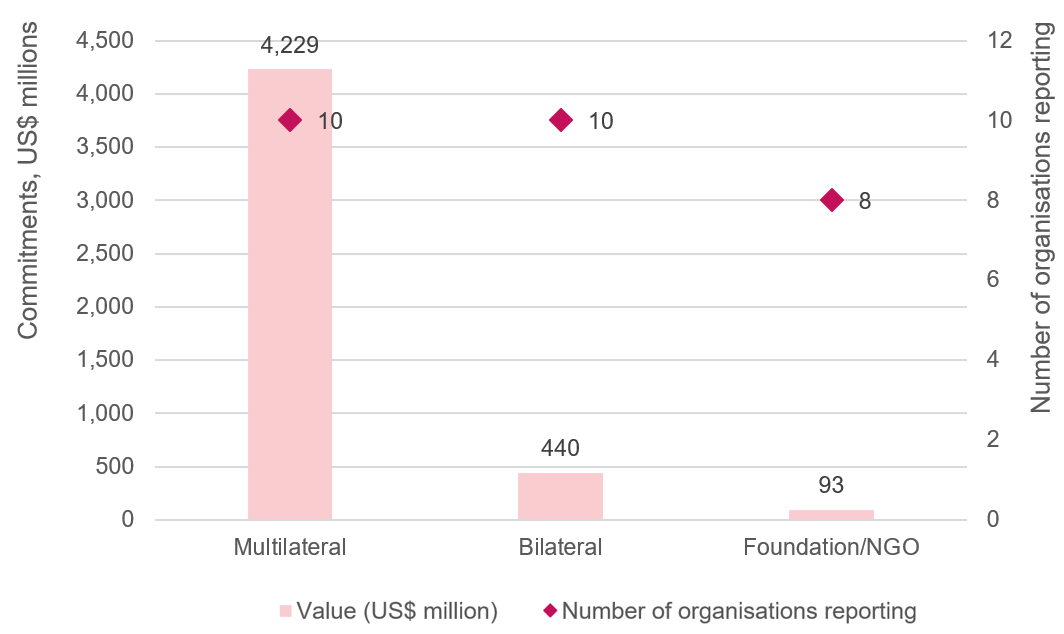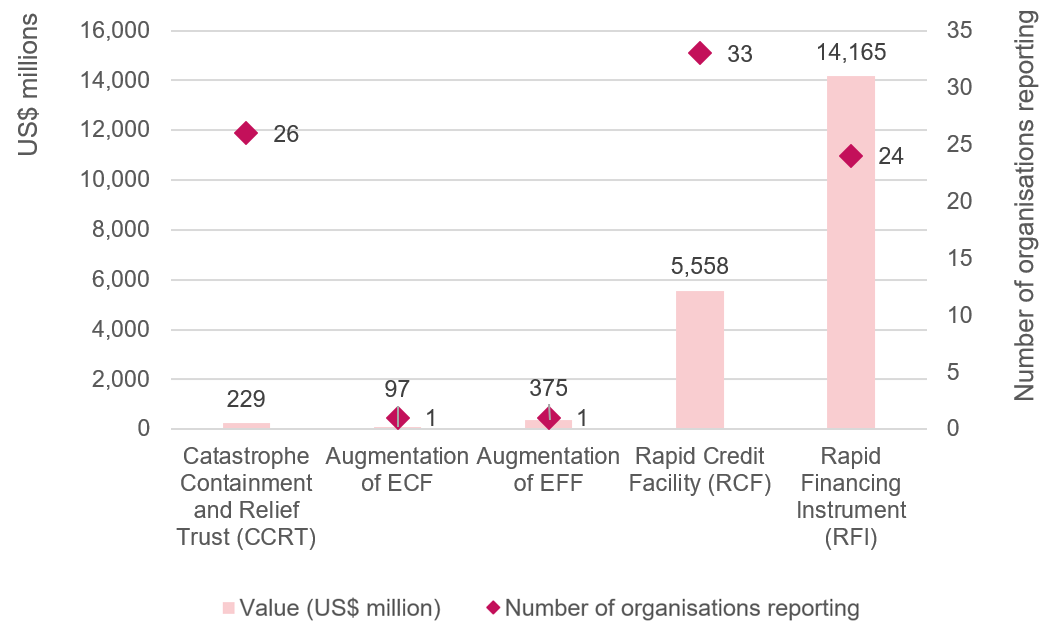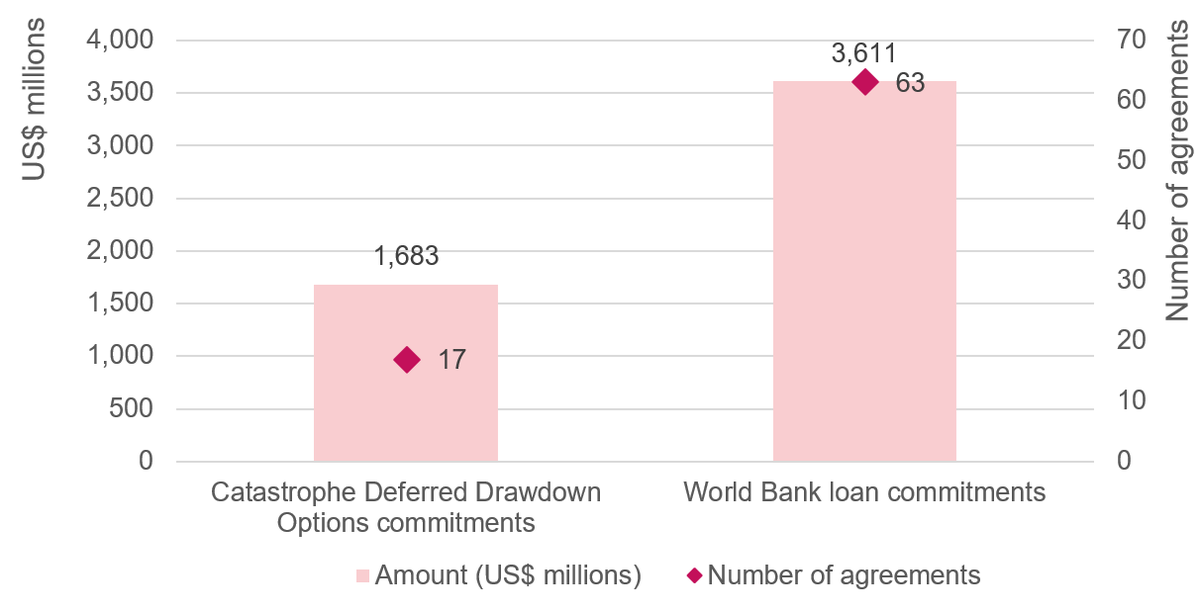The challenges of data on the financing response to Covid-19
This paper, examining the challenges of using financing data sources, launches our series on matching resources to needs in the global Covid-19 response.
DownloadsIntroduction
The speed with which the Covid-19 pandemic is spreading through the world appears, broadly speaking, to be proportional to the wealth of nations. Projections made by the London School of Hygiene and Tropical Medicine [1] suggest that in low-income countries, cases could peak up to six months after the virus gains a foothold. This gives these countries more time to be better prepared, and for the global community to learn how best to target its support.
The global financial response has been unprecedented. Huge volumes of resources are being pledged, committed and mobilised from diverse organisations through diverse funding instruments; however, getting an accurate and comprehensive understanding of the extent and detail of the response is difficult. Data on these activities is collected by a range of systems with various purposes and different ways of describing financial flows that may act over different timeframes.
Comparing or combining data from different sources is hard without a joined-up approach to connect the pieces in a coherent whole. How much is being raised? When is this actually being disbursed? Are the funds new or repurposed? Where is it going and for what purpose? How long is it taking to get there? And, how do these funding decisions relate to and impact on the resourcing of responses to other, non-Covid-19 humanitarian and development needs, both now and in the coming months?
Equally challenging are attempts to understand the needs and vulnerabilities of those countries (and the people within those countries) that are likely to struggle the most in dealing with the pandemic as well as their existing humanitarian and developmental challenges. Does the evidence exist to ensure that resources – for the Covid-19 response and for other needs – will go to where they are needed most in the most appropriate form?
Without a more complete picture, it is not possible for national governments or international organisations to make well-informed decisions in relation to resource mobilisation, or for others to scrutinise their actions.
Development Initiatives (DI), together with the Centre for Disaster Protection (CDP), is working to unravel the complexity of resource flows in relation to the needs that they are intended to serve. We have created this series, which aims to better understand the data everyone can access, to identify what is missing, and to try and join the data up to create a more coherent picture in a language that is accessible to all. In this first contribution we take a look at some of the key information systems tracking the global financial response.
Over the next few months, our analysts will piece together and explain a more complete picture of global financing; they will also develop a common approach to matching national vulnerabilities and needs to both international and domestic resources. We will share our learnings, observations and unanswered questions in a series of publications and visualisations.
The challenge of tracking funding to Covid-19
Figure 1 shows the value of Covid-19-related commitments and expenditures for two institutions – the UK government and the World Bank – as currently [2] reflected on their own websites and in three information systems: the UN Office for the Coordination of Humanitarian Affairs (OCHA) Financial Tracking Service (FTS), the International Aid Transparency Initiative (IATI) d-portal platform, and Devex’s platform of funding opportunities. As we explain, there are a number of reasons for these discrepancies including the purpose and scope of these different platforms and tools (for example, FTS aims to curate and publish data on humanitarian funding, whereas IATI provides data on both development and humanitarian activities). However, it illustrates the challenge for anyone trying to make sense of global financing.
Figure 1: Reported Covid-19-related commitments and expenditures by the UK and the World Bank
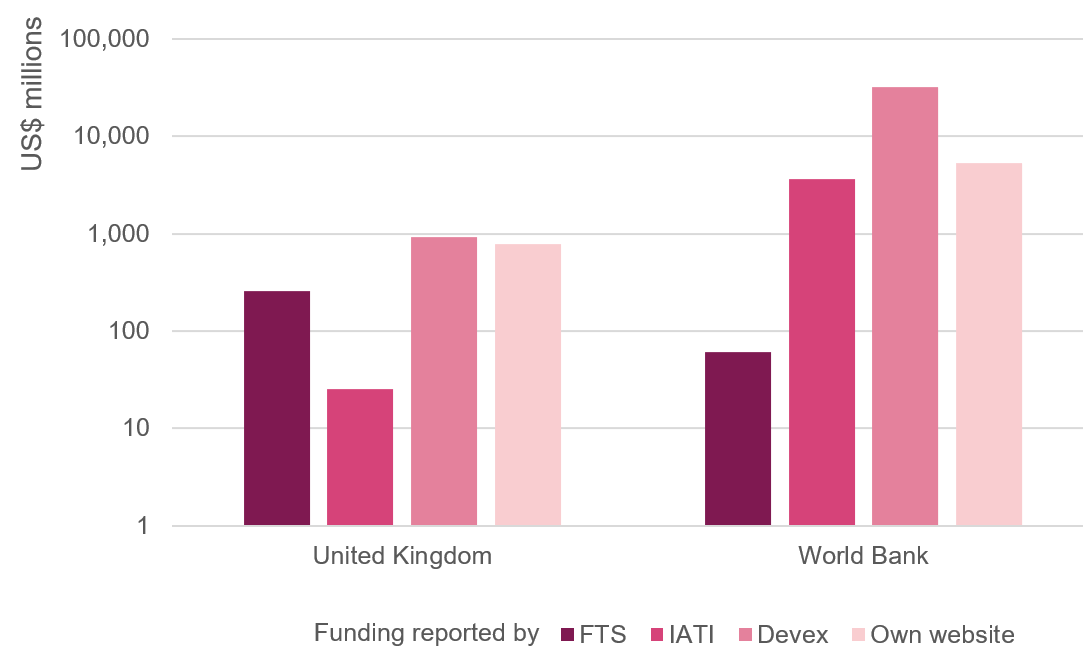
Reported Covid-19-related commitments and expenditures by the UK and the World Bank
Source: Development Initiatives based on data downloaded from FTS, d-portal, Devex and the UK’s Department for International Development websites on 19 May 2020, and from the World Bank website on 11 May 2020.
Notes: FTS: Financial Tracking Service; IATI: International Aid Transparency Initiative.
Making proper sense of this data – reconciling and disentangling the different forms and types of financial flows captured in these publicly accessible platforms and data standards – requires specialist analyst skills. Policy-makers, as well as those wanting to hold them to account, are faced with an unenviable task of deciding who to believe or what values to use. Indeed, the response to the pandemic has thrown into relief the silos within the international system, and the challenges of tracking, financing and programming across humanitarian and development responses.
Understanding resource flows to Covid-19
In all areas of financial activity – whether domestic, national or global – the range of available instruments can be confusing. The world of humanitarian and development financing is no different. How funds travel from source to final recipient, in what form, through which intermediaries and under what conditions is a complex process. Table 1 and Table 2 provide simple overviews and summaries of flows. These are a starting point for a conceptual framework and include flows with existing evidence on their direct relevance to the Covid-19 response. Given the fast-changing nature of the pandemic and the response, more financial flows will likely emerge or become directly relevant over time. This framework will therefore remain a work in progress as our research on resources directed to the pandemic response develops.
To pull together data from different sources on both local needs and global resources we need to develop clear taxonomies that define and categorise flows, responses and needs. In one sense it is possible to say that all socioeconomic vulnerabilities and all humanitarian and development resource flows are, in one way or another, related to the pandemic. This is not particularly helpful.
Table 2: A description of the financing flows to Covid-19
| Flow | Description | Relevance to Covid-19 response | Main stakeholders |
|---|---|---|---|
| Concessional loans |
Loans with interest below market rates, longer repayment periods or a
delay before repayment has to begin. |
Liquidity boost, primarily for governments to bolster health systems
and social protection, and to mitigate economic consequences of the pandemic. |
Multilateral development banks
Development finance institutions |
| Grants |
Non-repayable funds, usually provided by government or multilateral
donors, with the purpose of achieving humanitarian or development outcomes. |
Primary financial support to the humanitarian response; also used to
bolster health systems and social protection in recipient countries, and to mitigate economic consequences of the pandemic. |
Governments
Multilateral development banks |
| Debt relief |
Any form of debt reorganisation that relieves the overall burden of
repayable debt – for example, reducing interest rates on loans, extending the repayment schedule or writing-off a portion of outstanding interest payments. |
Alleviate fiscal stress on governments that face an economic downturn (and
thereby reduced revenue) due to the pandemic, thus freeing-up funds for responding to it domestically. |
Governments
International Monetary Fund |
| Non-concessional loans | Loans provided with interest at market rates. |
Liquidity boost, primarily for governments to bolster health systems
and social protection, and to mitigate economic consequences of the pandemic. |
Multilateral development banks
Development finance institutions |
| Foreign direct investment | Private direct investment in business abroad | Private investments in vaccine development and distribution | Private investors globally |
| Philanthropic giving | Donations from private individuals or grants from private foundations/companies |
Funding vaccine development and distribution; contributing to the
humanitarian response |
Private individuals, foundations and companies |
Source: Development Initiatives
Data sources on resource flows to Covid-19
What are the major sources of publicly available data on financial flows to the Covid-19 response? What part of the response picture do they currently show us? And, what are the challenges in making sense of the data they provide and reconciling this to make sense of the bigger picture? We outline four key data sources.
Financial Tracking Service
The Financial Tracking Service (FTS) is one of the information services provided by the UN Office for the Coordination of Humanitarian Affairs (OCHA) to collect, curate and publish data on humanitarian funding. It is used by humanitarian stakeholders, donors and implementers alike to trace funding flows and thereby identify gaps in the global humanitarian response. Its primary focus is to track whether funding meets the requirements set out by UN OCHA-coordinated humanitarian response plans (HRPs), though it captures funding flows outside of those plans to provide a more holistic picture of humanitarian funding.
A large number of government donors, UN agencies and NGOs report funding received or provided to the platform (by submission of Excel documents, an online reporting form, or via ingestion of funding data from the European Emergency Disaster Response Information System ). The reporting process is obligatory for implementing agencies participating in HRPs and otherwise voluntary. Data is updated in real time.
Funding flows can be recorded as pledges, commitments or paid contributions. The FTS defines commitments as legally binding funding obligations. Both commitments and paid contributions are counted towards the funding process against HRPs; FTS seeks to avoid double counting between the two through its data-curation process. Grants (either financial or in-kind) are the only type of funding flow that is captured. The FTS captures a range of flow characteristics that are specific to its source, to the flow itself and to its destination. These include, for instance, location, sector or emergency to be addressed.
FTS tracks funding progress against the Global Humanitarian Response Plan (GHRP) to Covid-19, launched on 25 March and updated on 6 May 2020. According to the most recent update, requirements for the humanitarian response set by the organisations participating amount to US$6.7 billion. Figure 2 shows that funding to the GHRP is at US$1.0 billion (about 15%) of the requirements.
FTS also tracks wider humanitarian funding (outside of the GHRP and intersectoral country plans) that is also responding to the Covid-19 pandemic. This shows US$640 million in addition to the funding under Covid-19-specific response plans, bringing the total humanitarian funding on FTS to respond to Covid-19 to US$1.6 billion (Figure 2 and Figure 3).
Figure 3: Covid-19 financing reported to FTS by source by organisation type
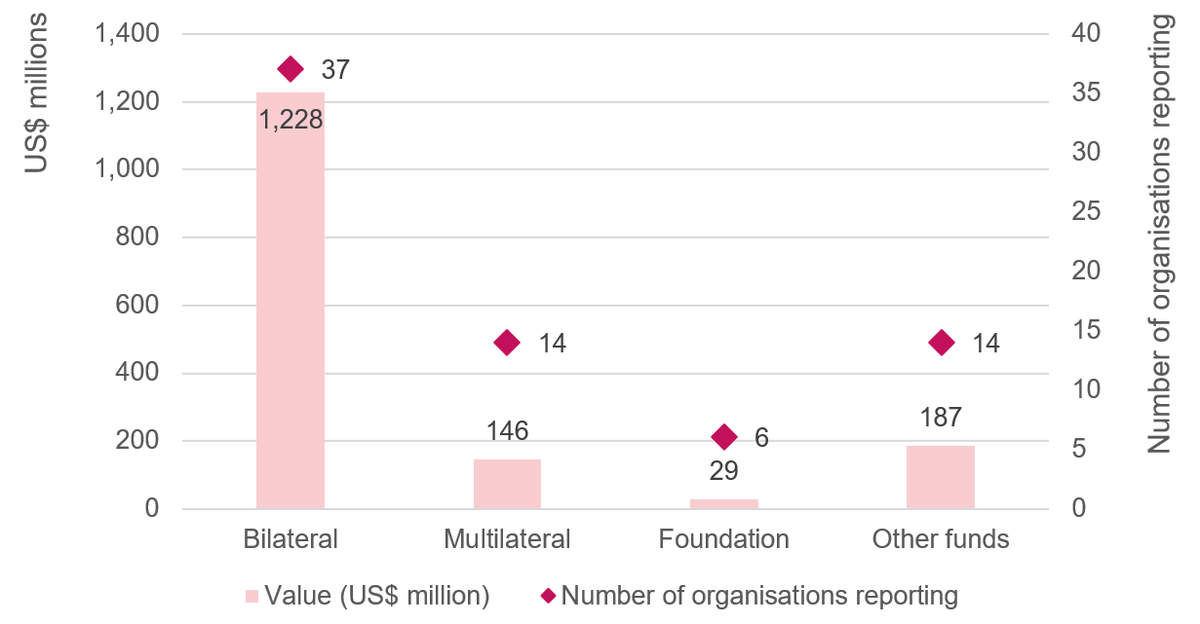
Covid-19 financing reported to FTS by source by organisation type
Source: Development Initiatives based on data downloaded from FTS on 19 May 2020.
Note: ‘Other funds’ includes contributions from country response funds and other pooled funds.
International Aid Transparency Index
The International Aid Transparency Initiative (IATI) maintains an activity-based publishing standard for tracking both development and humanitarian activities. As of 19 May 2020, 28 of its 700 active publishers had adopted its guidelines for flagging activities as being Covid-19 related, and there were 642 activities with a commitment value of over US$4.6 billion. [3] This number is increasing on a daily basis as more publishers implement the guidelines.
Data published through IATI represents activities at every step along the aid delivery chain. While this provides timely and detailed information from both funding and implementing agencies, the same activity is often reported by more than one participating organisation, and care needs to be taken to avoid double counting when attempting global aggregates. [4]
Work is underway to try and align FTS and IATI data, with an ongoing pilot project that seeks to enable the automatic ingestion of IATI data to the FTS platform from five donor and implementing agencies. However, substantial challenges remain. In addition, the Grand Bargain Transparency workstream has developed a prototype visualisation to show the humanitarian and development response to Covid-19, based on FTS and IATI data. Following initial consultations, an updated version of the prototype visualisation will be made public in early June, and interest canvassed among stakeholders on taking the prototype to scale.
International Monetary Fund and World Bank
The International Monetary Fund and World Bank both publish data on their financing to the Covid-19 response on their respective websites. As of 11 May 2020, over US$25 billion in loans have been committed by Bretton-Woods financing (IMF and World Bank) in response to Covid-19. These loans cover 86 countries, with the majority in sub-Saharan Africa.
Figure 5 shows that IMF support is being delivered through a variety of instruments. The Catastrophe Containment and Relief Trust (CCRT) provides information on country, value and date of debt relief agreements. This CCRT is a one-time agreement to suspend debt payments for several months. New loans are being issued through the Rapid Credit Facility (RCF), Rapid Financing Instrument (RFI), Augmentation of Extended Credit Facility (ECF) and Augmentation of Extended Fund Facility (EFF).
The World Bank has committed over US$3 billion in new loans to support the Covid-19 response. They are recorded in the Bank’s main project database and are also published through IATI . Details recorded include country, amount, purpose, date of board approval and source of financing (IDA grant/loan, IBRD loan).
Catastrophe Deferred Drawdown Options (Cat DDOs) [5] have also been issued on existing loans to provide quick access to emergency funds.
Devex
Devex , a media platform for the global development community, has developed a semi-public platform collating data from media and other sources, and analysing “funding opportunities” in response to Covid-19. This database contains over US$15 trillion worth of real or potential financing.
Table 3: Devex Analysis of funding opportunities (US$ million)
| Donor Type | Contract |
Funding
activity |
Grant |
Open
opportunity |
Program | Tender |
|---|---|---|---|---|---|---|
| Bilateral | 4 | 557,479 | 96 | 0 | 38 | 37 |
| Government | 26 | 11,742,779 | 355 | 25 | 374 | 0 |
| Multilateral | 51 | 3,286,921 | 137 | 76 | 40,488 | 1,992 |
| NGO/CSO | 8 | 572 | 22 | 24 | 0 | 0 |
| Philanthropic | 239 | 13,073 | 118 | 21 | 0 | 0 |
| Private Sector | 20 | 10,334 | 13 | 0 | 0 | 0 |
| Total | 349 | 15,611,158 | 741 | 146 | 40,900 | 2,029 |
Source: Development Initiatives data downloaded from Devex website on 17 May 2020.Notes: Devex defines the modalities within the database as follows: “Contract awards include information on projects that have been awarded to particular organizations, or organizations that may be shortlisted to be awarded the project in a given region. This information is often used by members to discover potential partners and competitors. Funding activity content offers early information on development funding opportunities and news related to major donors, foundations, private sector entities, media, and philanthropies. These are sourced from press releases, media outlets, donor country strategy reports, and more. Grants are nonprofit funding opportunities that provide financial assistance toward the achievement of specific project objectives. Open opportunities are grants with open-ended or cyclical deadlines. They can remain open for extended periods, usually until a grantee has been selected, or in cases of cyclical deadlines, they may be reopened after the deadline has elapsed if deemed necessary by the funding agency. The program report shares details around the project background, components, total budget and possible sectors of engagement. Tenders refer to opportunities that allow your organization to profit from the contract implementation. These involve the purchase of goods, works and construction services.”
Our plans for further work on financing to Covid-19
Development Initiatives will continue to make the links between these and other platforms recording global flows. For starters, we will place pragmatic parameters on our work, and focus on cross-border flows from all sources into low- and middle-income countries. We will include responses that focus on: immediate operational needs to meet the health and wellbeing (in the broadest sense) of the population; mitigating the economic shocks caused by the pandemic; and short-to-medium-term strengthening of the resilience of public health and other vital service infrastructures. We will put these flows in context alongside other development and humanitarian financing.
Our analysis will seek to piece together and make sense of the humanitarian and wider development landscape, establishing the bigger picture of financial flows to the Covid-19 response. We will also undertake detailed analysis of specific flows to answer key questions around the targeting of the financing.
Our Africa office will look at how these global flows, together with domestic resources, are being deployed at the country level. Furthermore, we will explore both the epidemiological modelling and longer-term resilience data for low-income countries (correlating these projections with both the Sustainable Development Goals and other indicators) to gain a clearer understanding of key vulnerabilities to better inform our analysis and our recommendations for the targeting of such finance.
As we work through the duplications and gaps in available data we trust that a common framework for joining up data will emerge.
Downloads
Notes
-
1
Centre for the Mathematical Modelling of Infectious Diseases, Projections of Covid-19 epidemics in LMIC countries (accessed 30 April 2020). https://cmmid.github.io/topics/covid19/LMIC-projection-reports.htmlReturn to source text
-
2
As of 19 May 2020.Return to source text
-
3
See: http://d-portal.org/ctrack.html?aids=COVID-19#view=main (accessed 19 May 2020)Return to source text
-
4
Particular care needs to be taken in tracking the flow of funds from bilaterals to the big multilateral agencies.Return to source text
-
5
"A Development Policy Loan with a Catastrophe Deferred Drawdown Option (Cat DDO) is a contingent financing line that provides immediate liquidity to IBRD-eligible (including Blend) countries to address shocks related to natural disasters and/or health-related events. It serves as early financing while funds from other sources such as bilateral aid or reconstruction loans are being mobilised." Available at: http://pubdocs.worldbank.org/en/526461507314946994/product-note-cat-ddo-ibrd-2018.pdfReturn to source text
Related content
Why do coronavirus-related poverty projections vary so widely?
This podcast explores why the differences in coronavirus poverty projections exist, focusing on three models that are making headlines at the moment.
How visible are the vulnerable in the data on coronavirus?
Claudia Wells argues that we need better data infrastructure to understand how the Covid-19 pandemic affects the most vulnerable and poorest people, what help is needed and whether support is working.
Coronavirus and aid data: What the latest DAC data tells us
How might the coronavirus pandemic impact aid spending? DI presents analysis of preliminary ODA (aid) data for 2019. Our briefing shows how much was given and in what form.
